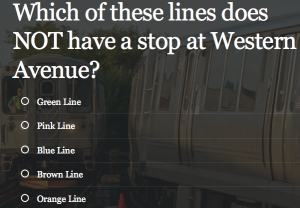May 12, 2009 – Nearly 20 years after the landmark Americans with Disabilities Act took effect and nine years after being sued in federal court, the CTA is still not readily accessible to hundreds of thousands of disabled Chicagoans.
Since the 1990 passage of the ADA, fixed-route public transit systems like the CTA have taken steps to become accessible, including installing elevators in train stations and providing lifts or ramps on buses. A lawsuit filed in 2000 by Access Living, Equip for Equality and nine disabled individuals required the CTA to take additional steps.
Yet three years after a court-ordered monitor stopped producing quarterly reports, interviews with riders and complaints filed with the Chicago Transit Authority show the system still has trouble providing consistent service to its disabled customers.
Rachel Siler, 23, said she frequently encounters impolite bus drivers, many of whom tell her the lift that allows her wheelchair to be wheeled onto a bus is broken. She’s found the CTA’s trains equally difficult to use. The elevators at train stations are frequently out of service, Siler said, and often incorrectly listed on the CTA’s Elevator Status Hotline (888-YOUR-CTA or 888-968-7282); the whiteboards in each station that are supposed to list elevator outages system-wide also are often wrong, she and other disabled customers say.
Larry Biondi, one of the plaintiffs in the Access Living case and a member of the CTA’s ADA Advisory Committee, says the whiteboards, which were required as part of the settlement, often cause him problems. Born with cerebral palsy, the 46-year-old has used a wheelchair since childhood and requires an elevator to ride the “L.”
Biondi makes regular trips on the Blue Line from his office at Progress Center for Independent Living in Forest Park to the busiest train station – Clark & Lake – to get to meetings for the CTA’s ADA Advisory Committee. Biondi said there have been multiple times when he checked the whiteboard posted at Forest Park to make sure Clark & Lake wasn’t on the list only to arrive in the Loop to find the elevator broken, forcing him to miss his meeting.
Siler, who works at Access Living, said she doesn’t understand why the problems she encounters keep happening.
“There has to be a more powerful elevator,” Siler said. “How can it go out so many times?”
CTA customers have filed complaints many times over the last five years reporting broken elevators, some out of service for weeks at a time. An unidentified customer who uses a wheelchair called the CTA in March 2004 to report the elevator at the Blue Line’s Rosemont station wasn’t working. A CTA employee helped the unidentified man up the station’s stairs while several passengers carried his wheelchair.
Three months later, a customer who was commuting to his job with a disabled co-worker filed a complaint about the elevator at Clark & Lake being out of service for the third time in two weeks. Frustrated by yet another elevator malfunction, the pair – one in a wheelchair – made their way to the Clinton station, only to discover the elevator was not accessible because of torn-up cement.
“We were forced to walk nearly a mile before taking the Metra back to Oak Park. It is ridiculous that the elevators at the busiest stop in Chicago are out of order so often,” the able-bodied customer said in his complaint.
The CTA declined to answer questions about the problems Siler, Biondi and others experience or provide details on how often elevators don’t work, making it impossible for many disabled customers to use the system. It’s also unclear if the lawsuit’s requirement that no fewer than three elevator-repair technicians and one helper be deployed whenever necessary is still in place.
In addition, the 2001 settlement required the CTA to rehabilitate every elevator at least 10 years old and to install automatic elevator activators, which prevent breakdowns due to severe weather. The settlement also mandated that the CTA strengthen its disciplinary procedures for employees who don’t properly assist disabled riders and maintain an electronic database of ADA-related complaints. And for five years, an independent monitor, attorney Shelley Sandow, reported each quarter on the CTA’s progress on making the system more accessible.
Sandow’s reports show the CTA did make improvements dictated by the settlement. But the types of problems described by the plaintiffs in the lawsuit – rude CTA employees and consistently malfunctioning equipment – continue to plague disabled customers.
A complaint filed in March 2008 by a customer traveling with her mother who uses a motorized scooter shows how one bad experience can sour riders. The two were waiting at a stop near the Field Museum when a CTA driver asked them if they wanted to get on the bus. The unidentified customer said the driver sarcastically asked if they realized it was a crowded bus, but the customer says there were empty seats and the aisles were not full.
“His attitude conveyed the perceived inconvenience we were causing him,” the customer wrote in an e-mail to the CTA. “Once he gave in to allow us onto the bus, I went to arrange the seats. He soon realized that the ramp would not automatically lower itself. Instead of lifting it with the handle as all other bus drivers had done for us before, he looked at me, told me the ramp wouldn’t work and expected me to get off the bus. We convinced him to help us lower the ramp manually, however, his condescending attitude had already hurt my mother.
“All in all, it was a saddening experience. I hope that no other disabled individual has to deal with him in the future. And I only pray my mother can enjoy the rest of her visit without being humiliated again for her disability.”
Because the CTA would not answer questions for this story, it’s not known what if any disciplinary action was taken against the driver.
Bruce McElerath, the board chairman of the Philadelphia-based Disabilities Rights Advocacy Group, said the problems riders with disabilities face on the CTA happen elsewhere, too. Rude employees and poor communication are issues nationwide, and several cities have had problems informing their riders of troubles on their tracks, he said. McElerath says this may be one of several flaws dating back to the ADA’s creation almost 20 years ago.
“One problem is nobody enforced the ADA, and it got placed under the Justice Department, who then would be overwhelmed with complaints and started throwing out cases because they didn’t have time,” McElerath said.
“A big issue now is that the ADA laws gave measurements for all bus doors and station entrances that fit manual wheelchairs, because that is what most people rode in the early 90’s when the ADA was passed. Since then, though, doctors have researched and technology has progressed, and we’ve learned that motorized wheelchairs and scooters are better for people. Problem is, these objects are much bigger and don’t fit through the doors.”
The CTA’s accessibility has improved since Congress passed the ADA. According to The Chicago Tribune, in August 1990 only 12 of the 143 train stations then in operation were labeled as handicap accessible; in August of 2001, 61 of 144 stations were. And now, the CTA says 88 stations – or about 61 percent – are accessible along with all 153 bus routes.
“Like all transit systems, they are far from perfect,” said Kevin Irvine, chairman of the CTA’s ADA Advisory Committee and senior transportation advocate for Equip for Equality, which also was a party to the 2001 lawsuit. “There is always room for improvement, but I think they are doing much better then they have historically.”
Laura Miller, managing attorney for Equip for Equality and one of the lawyers who helped Access Living with its case, continues to work with the CTA on spending $500,000 set aside for improving accessibility. So far, money has been spent on training videos for CTA employees and instructional videos for riders with disabilities detailing the best way to navigate the CTA. Other funds will be used to install centrally programmable LED/Audio systems for each of the 144 train stations.
Miller said she could not comment on whether the CTA is still complying with the requirements of the settlement, but she notes the LED/Audio system, which would bring instant updates on elevator malfunctions or train arrivals to each station, could address some of the issues Siler, Biondi and other disabled customers have had.
Siler continues to hope the CTA will become more accessible, though waiting for it to get better requires patience, she said.
“When are we ever going to be able to stop fighting with the CTA for our rights? It’s not going to get any better if we’re quiet and give up. It’s our freedom.”
Eli Kaberon contributed to this report.
Contact Danielle Desjardins at danielle.desjardins@hotmail.com.
Check out the rest of the CTA investigation:
Investigation Finds Handicapped Accessibility Issues Plague CTA by Zach Wilmes
Broken CTA Facilities, Slow Repairs Create Problems for Disabled Customers by Elizabeth Czupta
Complaints Against CTA Keep Climbing by Danielle Desjardins and Kaitlyn McAvoy
Injury and Equipment Breakdowns Continue to Trouble Some Disabled CTA Riders by Kirsten Steinbeck
Advisory Group Works to Improve Access for Disabled CTA Riders by Kirsten Steinbeck
ChicagoTalks Video: CTA Improves But Some Disabled Still Complain by Elizabeth Czupta
INVESTIGATION: Disabled And Downtown On The CTA by Eli Kaberon
INVESTIGATION: The Inaccessible CTA by Kaitlyn McAvoy
<!–[if gte mso 9]>Normal0< ![endif] >











Be First to Comment